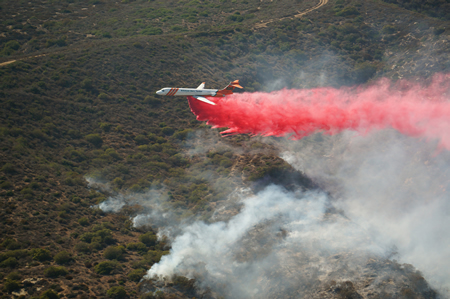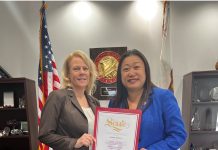
Photo by Greg Farnes
Public safety has usurped visual aesthetics as the motivation to underground utility cables citywide, says a report presented to the City Council Tuesday.
A huge undertaking if pursued, costs are expected to run in the hundreds of millions and would require voter-approved taxes and debt, according to a report laying out options and recommending initial actions. In the end, City Manager John Pietig said, some high-power transmission lines and street-lighting poles could still remain standing.
The plan includes the difficult option of buying the utility infrastructure from Southern California Edison and San Diego Gas and Electric to expedite the process. If the city did acquire the now-franchised service from the two utility companies, it would be a first in California history, the city’s report says. Other cities operate their own utilities but none as a result of a buy-out, according to the presentation.
Laguna’s move toward undergrounding utility wires citywide due to fire danger prompted new legislation, state Senate Bill 1463. The proposed legislation, introduced by Orange County Senator John Moorlach, would require the California Public Utilities Commission to prioritize communities most at risk of wildfires in order to determine who is responsible for removing the fire hazards.
The PUC already requires utility companies to set aside funding for undergrounding utilities in specific cases, but Laguna officials are dissatisfied with the pace and scope of the process. With the city hoping to qualify for state and federal funds to underground wires, the report points out that the commission’s first draft of a map to identify communities with wildfire risk from overhead wires omitted Laguna Beach altogether.
To emphasize Laguna’s fire risk, Fire Chief Jeff LaTendresse outlined recent local wildfires, starting with the arson fire in 1993 that destroyed 441 homes and charred 14,333 acres with $838 million in losses, the seventh most costly wildland fire-related disaster in U.S. history. Since 1993, five more fires ignited by falling trees, electrical surges molten causing metal to erupt from wires and downed cables have occurred, three of them along Laguna Canyon Road. The information has been presented to state officials, council member Bob Whalen said.
The council approved spending $300,000 for expert input to analyze the cost of burying utilities citywide. The council also approved hiring a manager to expedite undergrounding projects in neighborhoods and on Laguna Canyon Road at Big Bend, which is expected to start April 4 with lane closures and traffic delays. The new employee will also oversee already approved bicycle, pedestrian and safety projects along the canyon road.
For Laguna to become the provider of electricity to the community may be cost-prohibitive, the report says. After a transformer sparked a fire last July, council members Whalen and Rob Zur Schmiede met with Southern California Edison and San Diego Gas and Electric officials and found they were not remotely interested in footing the cost of citywide undergrounding, the council members said. Acquiring the utilities would most likely require eminent domain, taking private property for public use, said Pietig, an expensive process he expects the utility companies to “aggressively oppose.”
Asking utility companies to upgrade equipment and the city to more consistently manage surrounding vegetation was listed as the least costly option. It’s not as safe as undergrounding, Pietig acknowledged.
The council also approved surveying residents about the issue and how to pay for it. The public survey will be conducted prior to the November general election in case a ballot measure is required. Residents have limits on how much debt or tax increases they’re willing to take on, said Pietig, and other city priority projects need to be considered. The public opinion survey, conducted by FM3 of Los Angeles, will also ask residents to prioritize other city projects.
If residents opt to pay for undergrounding, those who have already paid for neighborhood undergrounding — averaging $30,000 per property — would not be double-charged, Pietig assured.
Potential funding sources include increasing the sales or transient occupancy tax, largely paid by visitors, Whalen noted. Other possibilities include a utility users’ tax, a bond measure or a special tax levied on property owners, all needing voter approval. The citywide undergrounding project would require more than one source of funding and is expected to take at least 10 to 15 years, the report says.
Undergrounding on Laguna Canyon Road is a top city priority due to fire hazard. The road sees 41,000 cars daily and vehicles have collided with utility poles at least 46 times there since 2007, the report says.
The open space surrounding Laguna Beach has been designated a “very high fire hazard severity zone,” by state fire authorities and encompasses 90 percent of the city, according LaTendresse.
The council also approved an engineering survey of five miles along Laguna Canyon Road to determine exact costs of undergrounding. A new ordinance, ready for council approval, will compel utilities and property owners to underground any new, replaced or relocated utility equipment, City Attorney Phil Kohn said. By adopting the ordinance, city law would align with the proposed legislation, which will determine if utilities are responsible for removing equipment posing a fire hazard, he said.
Funding for the approved recommendations will come from the city’s street-lighting fund, which carries a $3.9 million balance.





Wouldn’t it make sense to subsidize the under grounding project by surcharging commuter and visitor cars driving LCR? If LCR became a TOLL ROAD the funds would be utilized cover cost to underground poles for fire and vehicular safety on the dark road and remaining to build infrastructure to protect pedestrian and bicycles from injury from cars.
Residents would have 1 car per residence exempt from paying a Toll by using shoppers permit.
How much would the equipment cost to make the Canyon into a toll road? Where would it start? Before El Toro Rd or after? How would this impact traffic on Coast Hwy from people unwilling to pay the toll? Would the toll end after the underground project is paid for? I’ll answer that one for you: Of course not. I can tell you right now a toll road would have been devastating for me as a teen driver growing up in Laguna, and it sure wouldn’t be so great now when I go to visit my dad. Not everyone is made of money who lives there (YET!). Laguna has only 3 ways into town- making one toll would be… not very nice. Maybe a 1 cent sales tax on some item or other? Sure seemed to work for Measure M- I was thinking that would be a great idea for the city to buy the movie theater downtown since it is one of Laguna’s few non-natural landmarks.